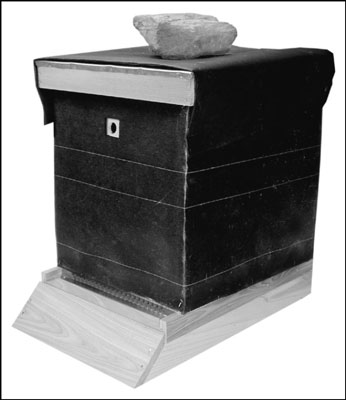Most nectar and pollen sources become scarce as days become shorter and weather cools in autumn. All in all, as the season slows down, so do the activities within your beehive: The queen's egg laying is dramatically reduced, drones begin to disappear from the hive, and hive population drops significantly.
Your bees begin bringing in propolis, using it to chink up cracks in the hive that may leak the winter’s cold wind. The colony is hunkering down for the winter, so you must help your bees get ready.
Watch out for robbing during this time (other bees would love to steal honey from your hives).
Your autumn beekeeping to-do list
When helping your bees prepare for the upcoming hardships of winter months, you must
Inspect your bees (look inside the hive) and make certain that the queen is there. The easiest way is finding eggs. One egg per cell means the queen is present.
Be sure to look for eggs, not larvae. Finding eggs means that the queen was present two days ago. Larvae, on the other hand, can be three to eight days old. Thus, merely finding larvae is no guarantee that you have a queen.
When you wait too late during autumn, you discover that eggs and larvae are few and far between. In that case, actually finding the queen is the surest way to check. Be patient, and look carefully.
Determine whether the bees have enough honey. Make certain that the upper deep hive body is full of honey.
In cooler, northern climates, hives need about 60 pounds or more of honey as they head into winter. You’ll need less honey reserves (30 to 40 pounds) if your winters are short (or nonexistent).
Feed and medicate your colony. They’ll accept a 2-to-1 sugar-syrup feeding until colder weather contracts them into a tight cluster. At that point, temperatures are too cold for them to leave the cluster, so feeding them is useless.
* Consider treating your colony with either Terramycin® or Tylan® (both are anitibiotics) as a prophylactic precaution against AMB and EFD disease.
Provide adequate ventilation. During winter, the temperature at the center of the cluster is maintained at 90 to 93 degrees F. Without adequate ventilation, the warm air from the cluster rises, hits the cold inner cover, and condensation drips down onto the bees as ice-cold water.
Wrap the hive in black tar paper if you’re in a climate where the winter gets below freezing for more than several weeks. Make sure that you don’t cover the entrance or any upper ventilation holes. The black tar paper absorbs heat from the winter sun, and helps the colony better regulate temperatures during cold spells. It also acts as a windbreak.
Provide a windbreak if your winter weather is harsh. It is hoped that you originally were able to locate your hives with a natural windbreak of shrubbery. But if not, you can erect a temporary windbreak of fence posts and burlap. Position it to block prevailing winter winds.
Add a mouse guard to the front entrance of the hive.
 Wrapping your hive in tar paper helps protect your colony from harsh winter winds and absorb the warmth of the sun. The rock on top keeps the paper from blowing off. The metal mouse guard keeps unwanted visitors outside the hive.
Wrapping your hive in tar paper helps protect your colony from harsh winter winds and absorb the warmth of the sun. The rock on top keeps the paper from blowing off. The metal mouse guard keeps unwanted visitors outside the hive.
Your autumn time commitment for your hive
Figure on spending three to five hours total to get your bees fed, medicated, and bedded down for the winter months ahead.

